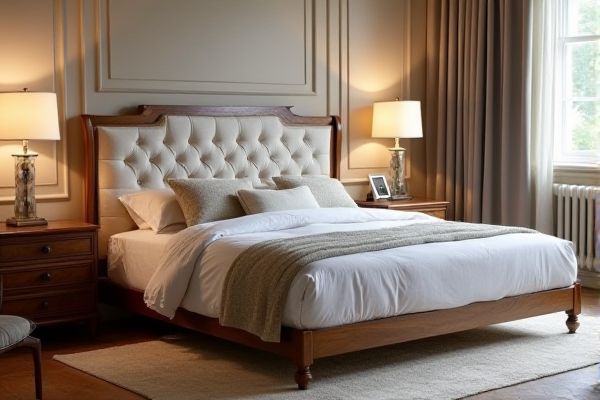
Choosing between an upholstered bed and a wooden bed depends on your preference for comfort versus durability; upholstered beds offer a soft, padded surface ideal for lounging, while wooden beds provide a sturdy, timeless appeal with natural textures. Explore the rest of the article to discover which bed type suits your bedroom style and lifestyle needs.
Table of Comparison
| Feature | Upholstered Bed | Wooden Bed |
|---|---|---|
| Material | Fabric or leather upholstery with padding | Solid wood or engineered wood |
| Comfort | Soft headboard offers extra comfort | Firm, no padding |
| Style | Modern, elegant, customizable colors and textures | Classic, rustic, versatile finishes and grains |
| Durability | Moderate; fabric prone to stains and wear | High; long-lasting, resistant to scratches |
| Maintenance | Requires regular cleaning and fabric care | Easy to clean and maintain with polish |
| Weight | Generally heavier due to padding and frame | Varies; can be heavy or lightweight depending on wood type |
| Price Range | Mid to high, depending on upholstery quality | Wide range; affordable to premium based on wood type |
Introduction to Upholstered vs Wooden Beds
Upholstered beds feature a cushioned frame covered in fabric or leather, providing a soft, luxurious feel and customizable style options, ideal for comfort and aesthetics. Wooden beds offer durability and a timeless, natural appeal with solid construction from materials like oak, pine, or walnut, known for their sturdiness and longevity. Both bed types vary in maintenance requirements and design versatility, influencing their selection based on personal preferences and bedroom decor.
Design and Aesthetic Appeal
Upholstered beds offer a soft, luxurious look with fabric or leather finishes that can be customized in various colors and textures to complement modern or classic interiors. Wooden beds provide a timeless, natural aesthetic with rich grain patterns and a sturdy frame that suits rustic, minimalist, or traditional designs. Your choice depends on whether you prefer the cozy elegance of upholstery or the enduring charm of wood for your bedroom decor.
Comfort and Ergonomics
Upholstered beds offer superior comfort through padded headboards and soft fabric surfaces that provide ergonomic support for your back and neck during reading or resting. Wooden beds excel in durability and natural firmness, promoting better spinal alignment and offering a sturdy foundation for your mattress. Your choice depends on whether you prioritize plush comfort or solid ergonomic support for restful sleep.
Durability and Longevity
Upholstered beds feature fabric or leather coverings that may wear out or stain over time, requiring regular maintenance to preserve their appearance and durability. Wooden beds, particularly those made from solid hardwood like oak or maple, offer superior longevity due to their robust construction and resistance to daily wear. Choosing a wooden bed often results in a longer-lasting investment, while upholstered beds provide comfort and style but may need replacement or reupholstering sooner.
Maintenance and Cleaning
Upholstered beds require regular vacuuming and spot cleaning to prevent dust accumulation and fabric stains, with professional cleaning recommended for deep maintenance. Wooden beds are easier to maintain, needing only occasional dusting and polishing to preserve the finish and prevent wood cracks. Both types benefit from avoiding exposure to excessive moisture and direct sunlight to extend their lifespan and appearance.
Material and Construction Quality
Upholstered beds feature a wooden or metal frame covered with foam padding and fabric or leather, offering a soft, cushioned surface that enhances comfort and style. Wooden beds are constructed from solid wood or engineered wood, providing robust durability and natural aesthetic appeal with visible grain patterns and sturdy joinery techniques. High-quality construction in both types ensures longevity, but wooden beds typically offer greater structural strength, while upholstered beds prioritize comfort and design versatility.
Price Comparison
Upholstered beds generally come at a higher price point due to the cost of fabric, padding, and detailed craftsmanship, often ranging from $500 to over $2,000. Wooden beds typically offer greater affordability and durability, with prices starting around $300 and varying based on wood quality and design complexity. You can achieve better value by assessing your budget against style preferences and maintenance requirements for each bed type.
Customization and Versatility
Upholstered beds offer extensive customization options, including a variety of fabrics, colors, and tufting patterns that can be tailored to match any interior design style. Wooden beds provide versatility through different wood types, stains, and finishes, allowing for a natural aesthetic that can range from rustic to modern. Both materials support modular designs, but upholstered beds often feature additional elements like built-in storage or adjustable headboards for enhanced functionality.
Health and Allergy Considerations
Upholstered beds typically use fabric and padding that can trap dust mites, allergens, and pet dander, posing a higher risk for allergy sufferers and requiring regular cleaning to maintain a healthy environment. Wooden beds offer a hypoallergenic alternative due to their non-porous surfaces that do not harbor allergens as easily and are simpler to clean thoroughly. Choosing a wooden bed with natural finishes minimizes exposure to chemical irritants often found in some upholstery treatments, promoting better indoor air quality and reducing allergy symptoms.
Which Bed is Right for You?
Choosing between an upholstered bed and a wooden bed depends on your style preferences and maintenance needs. Upholstered beds offer a soft, luxurious feel and come in various fabrics to complement your bedroom decor, while wooden beds provide durability and a timeless, natural aesthetic. Your decision should consider factors like budget, room ambiance, and ease of cleaning to ensure the bed aligns with your lifestyle and comfort requirements.
 homyna.com
homyna.com